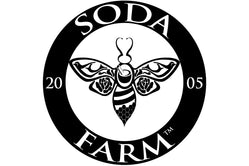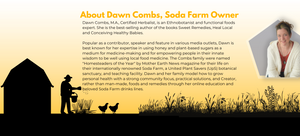What Is "Whole Plant Health"?
What is "Whole Plant Health" To Me?
I speak a lot about “whole plant health”. You'll find the idea in each of my three books to day. But it strikes me that I might not have taken the time to fully explain what I mean. I think it’s really important to define this as a foundational principle of what I believe and what I teach. If you are visiting here and deciding whether you will or won’t use me as a resource, this is critical.
Is It Vegetarianism?
Nope!
Do You Mean We Have To Use All Parts of The Plant?
NO! I'm talking about a true holistic approach to how we use plants instead of the reductionism that is so popular in today's medical science. The answer to my philosophy lies in my training as a scientist... or rather my reaction to my training....
I am university trained as a botanist. This means that I study the physiology, structure, ecology, distribution, classification and economic importance of plants. Within this field of study, I am considered an ethnobotanist, which means I am interested in how humans make use of, tell stories about and have relationship with the physiology, structure, ecology, distribution, classification and economic importance of plants. As an ethnobotanist I am most interested in the way these relationships occur in relation to the medicinally useful chemicals in plants.
I am often called an herbalist interchangeably with my title as ethnobotanist. Both herbalists and ethnobotanists often look at plants in a way that I find to be problematic. Many herbal formulations operate as a function of choosing one chemical or another from the plant in question. We see this in tinctures, essential oils, even teas that isolate only what is soluble in the medium in question and leave the rest of the plant's operating system (so to speak) behind.
As an ethnobotanist, I was trained to head out into glamorous places like the rainforest to gather information on unknown medicinal plant species. The idea is simple, get to know the local healers and walk with them to learn what plants they have traditionally used for various ailments. Once a promising plant is identified, the ethnobotanist gathers samples and sends them back to a laboratory in the United States where they are analyzed for their chemical make-up.
In principle, finding the active chemicals in important plants so that we can synthesize them is a good idea. The resulting medicine is then based on a lab creation rather than dependent upon denuding the rainforest of that particular plant, causing untold damage in the process to other plants, animals and humans.
Unfortunately, over the years I have come to the realization that our ability to determine what is “active” in a plant is limited by our human understanding of the chemicals found therein. We just haven’t been able to classify and describe everything in our environment yet- and plants are no exception.
In most any given plant under examination, the very gifted and intelligent folks in the lab will be able to identify a good number of the chemicals but there are almost always a pretty large number of these chemicals that we simply don’t understand. Sometimes we can narrow the unidentified constituents down to a known group, but go no further.
This is much like the human appendix or tonsils. They are constituents in the human body. For many years we didn’t really understand what they did and could find no “activity” with any of our scientific abilities of the time. Thus, many people have had their appendix and tonsils out in non-emergency situations because the belief was that they just didn’t do anything. Only now, as our abilities are advancing are we learning that there are indeed functions undertaken by these seemingly useless organs and…. well…. oops.
Inside every plant there is a world of chemical interaction. Some of this we understand in parts and pieces. In some cases, we even understand some of the chemical interplay. In large part, I would put forth that we don’t completely understand what is going on inside the complex plant system of say, comfrey.
There are chemicals inside comfrey that, if isolated and administered outside of the system, are known to cause problems in the human body. We know this through our scientific ability. That said, the historical evidence of the plant shows people using the whole leaf and often as a pot herb (meaning eating it for Sunday dinner!). They didn’t isolate out any one chemical, they ingested the plant as a whole system into the body and subsequently failed to note any problems.
Are Herbalists and Ethnobotanists Wrong?
No. This isn’t to say that there is no value for medicines that isolate chemicals any more than it is wrong to use herbal formulas that do. There is a time and a place for each.
There is a time to remove the appendix. Perhaps the individual is so threatened by an imminent rupture and regardless of the function that we remove when we take out the appendix, it is worth the “side effect”. In the same way, there is a time and a place where the isolation of one chemical from a plant is worth the side effect that occurs when we remove it from its system of checks and balances, buffers and potentizers.
I would instead like to make the suggestion that we need to err on the side of wholeness in our healing modalities as much as possible.
Whole Plant Health
When we use plants in their whole form, we are taking the system, as it was working, directly into our body. Nothing inappropriate is amplified, and it is just possible that some of the things we believe are dangerous on their own have a benefit when left amid both the chemicals we understand and those we do not yet. After all, in the field of ethnobotany the same pyrrolizidine alkaloids that are vilified in comfrey have a long history of being studied for their cancer fighting abilities.
Hippocrates said, “Let they food be thy medicine and thy medicine be thy food.” There is no more pure form of whole plant health than that. It is why I teach what I teach and create products the way I do.


